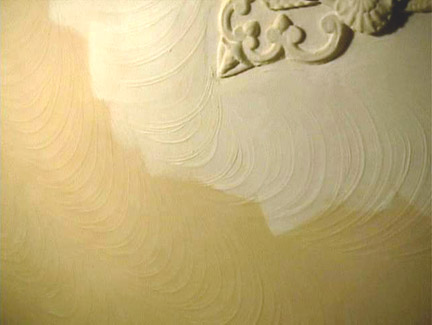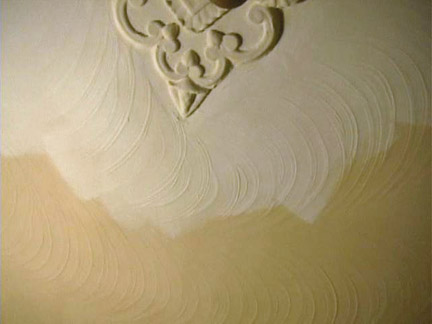
|
Lorna Mills and Sally McKay
Digital Media Tree this blog's archive OVVLvverk Lorna Mills: Artworks / Persona Volare / contact Sally McKay: GIFS / cv and contact |
View current page
...more recent posts
A good link on William Miller and the Apocalyptic Movement.
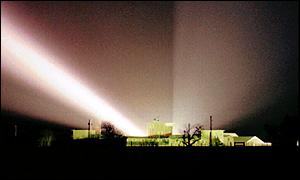
Waco
...and from an explanation of apocalypse literature:
Daniel tells the story of the collapse of Colossus. Tell us that story, and then what [Daniel] meant by it.
... Nebuchadnezzar has a dream, and he asked his court wisemen to interpret it, but none of them can. Only Daniel has the power to understand this dream. And the dream is of a giant statue, a colossus, made of different metals. The head is of gold, the shoulders and chest are of silver, the waist is of bronze, the legs are of iron, the feet are of iron mixed with clay. And these different metals represent different kingdoms that will succeed one another in the history of the world. ... In Daniel's interpretation, however, these refer to the succession of kingdoms after the Babylonians, the very kingdoms that are in charge of the Jews, ending with the Seleucids, who are the feet of clay, whom the forces of God crumble, cause the statue to collapse and this gives rise to a new kingdom of Israel.
Is apocalyptic writing always a response with concrete [circumstances], or is it more mystical?
Really, all apocalyptic literature is much more a response to a concrete set of circumstances, often political circumstances that drive this sense that we have to look for a mode of deliverance from God. And Daniel was, as a book, really responding to the political crisis of Antiochus Epiphanes and the political forces of war that are all about. ... For the people of this period there's really no difference between religion and politics. We can't simply look at this work as if its symbolism of good and truth and beauty are divorced from the political reality that's all around them. ...
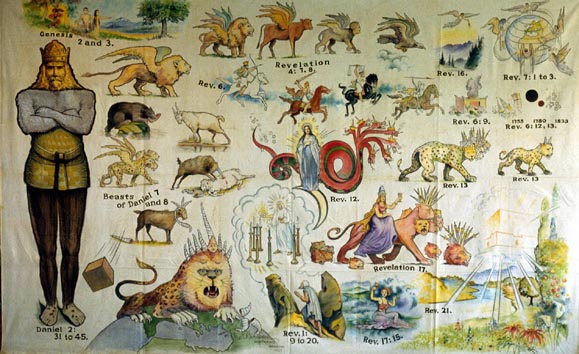
George E. Bingham Bingham Prophecy Chart 1927, Tempera and ink on muslin 7' 5" x 11' 8.5"
"The Jenks Collection holds one of the world's largest collections of "Prophetic Charts," over thirty items in all. Dating from 1842 to the 1930s, these charts were used by preachers in the adventual movement to help elucidate their presentations. Some were formally published or produced by trained artists, but many were the product of persons with little artistic background who brought a highly original and vigorous style to the interpretation of the apocalyptic visions of the Bible (the Book of Revelation and the second chapter of Daniel). Ranging from wall charts to massive banners (the largest is approximately 8 by 40 feet), the charts were usually made of canvas, painted with various materials and many show the ravages of weather, outdoor display (including nail holes and attached ropes), and the wear associated with long years on the road from camp meeting to camp meeting."
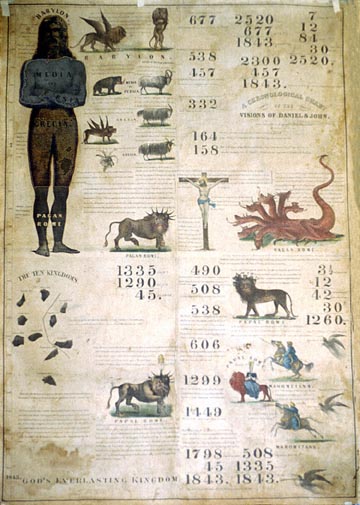
A Chronological chart of the visions of Daniel and John.
Lithograph; Devised by Charles Fitch with the assistance of Apollos Hale;
lithographer, B.W. Thayer & Co., Boston, 1842.
from Anthony Easton:
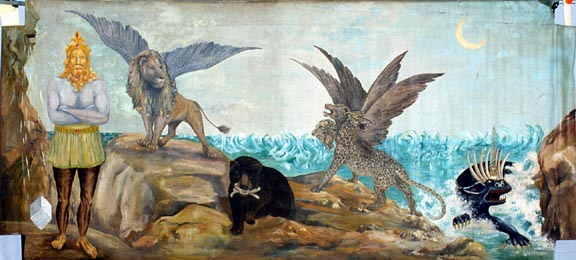
Henrietta Black (1900-1971), Daniel 2 and 8, 1935 Paint on canvas 4' 11.5" x 10' 8.75"
Remember the day of disappointment was 90 years before this picture was painted
[only Anthony would "remember" this, so the Day of Disappointment refers to the Millerite's specific date for Christ's return: October 22, 1844. He didn't show up. -L.M.]
collection of prophetic info from the 19th century Millerites, including some fascinating examples of last days chronographs and time lines. The formal components of the work, including the goldish yellow to indicate heaven and the non infographic work, including a strange and lovely illustration of the book of Daniel, suggest aesthetically the connections that have been made by the Millerites and other American prophetic Protestant sects (i.e. the demons and dragons look watchtowery, Hulbert's tree of life looks shakery, and the colossus of Daniel looks lds.) (its also interesting how much the Millerites put on Daniel. Carol Crown, who did a show of biblically based apocolyptic art from the American south last year, and who is an art historian, writes about some similar themes here a long article with some images that mostly are in black and white, she points out issues of scale, and how even at gigantic scale, the information contained in them falls off the edges or is packed into most available surfaces...which I think is one of the things that marks the best of Evangelical or religious work. She fails to mention the use of colour as both a aesthetic and informational code which is problematic. This is esp. true for the Millerites obsession with the images of Nabuchnezzer in Daniel 2:32-35:
The head of this image was of fine gold, its chest and arms of silver, its middle and thighs of bronze, its legs of iron, its feet partly of iron and partly of clay. As you looked, a stone was cut out by no human hand, and it struck the image on its feet of iron and clay, and broke them in pieces. Then the iron, the clay, the bronze, the silver, and the gold, all together were broken in pieces, and became like the chaff of the summer threshing floors; and the wind carried them away, so that not a trace of them could be found. But the stone that struck the image became a great mountain and filled the whole earth.
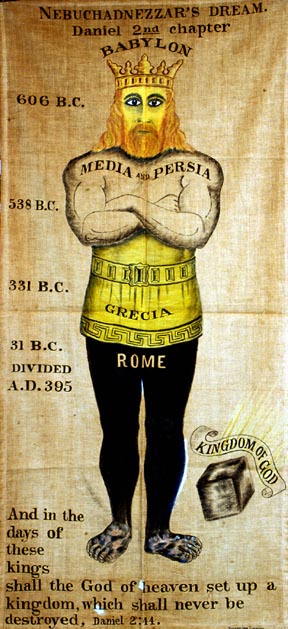
Josephine Lawson Prophecy Chart, Colossus of Daniel 2,
1917, Oil, tempera, and ink on cotton muslin 42.5" x 20"
